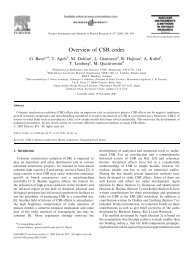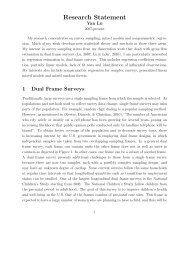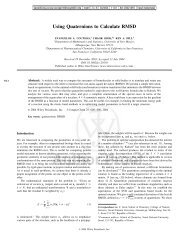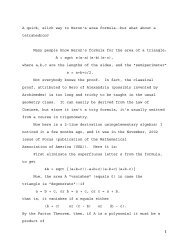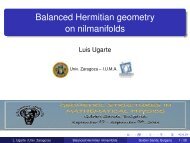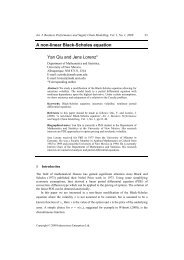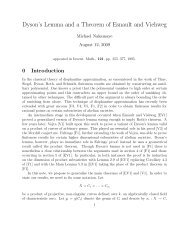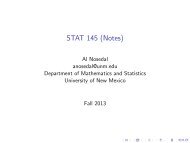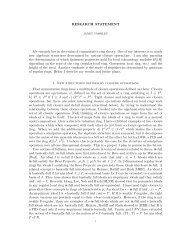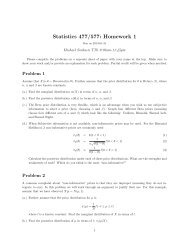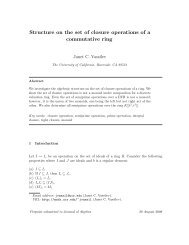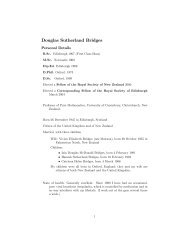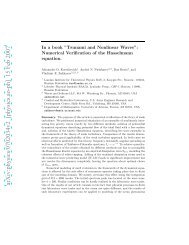OEO Office of Equal Opportunity - Department of Mathematics and ...
OEO Office of Equal Opportunity - Department of Mathematics and ...
OEO Office of Equal Opportunity - Department of Mathematics and ...
Create successful ePaper yourself
Turn your PDF publications into a flip-book with our unique Google optimized e-Paper software.
300 ARTS AND SCIENCES<br />
degree in a field other than Speech <strong>and</strong> Hearing Sciences are<br />
encouraged to apply. Advisement materials specifying admission<br />
requirements <strong>and</strong> related material are available upon<br />
request from the department <strong>and</strong> on the department Web site<br />
at http://www.unm.edu/~sphrsci/. All applicants should obtain<br />
<strong>and</strong> review these materials prior to initiating the admission<br />
process.<br />
Students entering the graduate program must have earned<br />
at least a C in the required support courses in biological,<br />
physical, behavioral, <strong>and</strong> social sciences <strong>and</strong> mathematics<br />
<strong>and</strong> statistics listed under SHS Major Study Requirements.<br />
These courses may be the same courses used to meet other<br />
college or University requirements. They may not include<br />
remedial course work. Students who have not completed<br />
these requirements will be required to do so within the first<br />
three semesters after acceptance into the graduate program<br />
in order to continue their enrollment.<br />
All students entering the graduate program are responsible<br />
for completion <strong>of</strong> the following prerequisite courses or their<br />
equivalent within the first 3 semesters <strong>of</strong> graduate enrollment,<br />
with a grade <strong>of</strong> at least B-: SHS 303, 510 (310), 541 (321),<br />
330, 425, 528 (428), 530 (430), 431, 458 <strong>and</strong> 559 (459).<br />
Courses or their equivalents that were taken more than six<br />
years before entering the graduate program, or courses for<br />
which a grade lower than B- was received, cannot be used to<br />
fulfill this requirement. The graduate advisor, in consultation<br />
with the Curriculum <strong>and</strong> Advisement Committee, will determine<br />
whether a course may be considered equivalent <strong>and</strong><br />
will decide how the requirement must be fulfilled: by taking or<br />
re-taking the course, by testing out, or by auditing.<br />
The speech-language pathology program includes the<br />
required support courses (see paragraph 2 above) <strong>and</strong> SHS<br />
300 <strong>and</strong> 400 level courses listed above as well as the following<br />
academic courses: SHS 500 (at least four enrollments to<br />
include no more than two summer sessions), 506, 507, 517,<br />
525, 531, 533, 534, 535, 550, 558 <strong>and</strong> two 500 level electives<br />
that may be selected from department course <strong>of</strong>ferings or<br />
from course <strong>of</strong>ferings from a variety <strong>of</strong> departments subject<br />
to approval by the SHS department. SHS 506 must be taken<br />
in the first year <strong>of</strong> enrollment in 500-level classes. A minimum<br />
grade <strong>of</strong> B is required for all 500 level course work.<br />
Speech <strong>and</strong> Hearing Sciences<br />
(SHS)<br />
*302. Introduction to Communicative Disorders. (3)<br />
(Also <strong>of</strong>fered as SPCD 302.) The nature <strong>of</strong> speech, language<br />
<strong>and</strong> hearing disorders in children <strong>and</strong> adults; overview <strong>of</strong><br />
speech <strong>and</strong> hearing anatomy <strong>and</strong> physiology; multicultural<br />
issues; emphasizes the impact <strong>of</strong> communicative disorders<br />
on individuals <strong>and</strong> families.<br />
*303. English Phonetics. (3)<br />
(Also <strong>of</strong>fered as CJ, LING 303.) An introduction to the<br />
physiological mechanisms underlying speech production, the<br />
linguistic classification <strong>and</strong> transcription <strong>of</strong> speech sounds,<br />
the acoustic properties <strong>of</strong> speech sounds, the relationship<br />
between phonetics <strong>and</strong> phonology <strong>and</strong> applications to<br />
speech pathology.<br />
310./510. Anatomy <strong>and</strong> Physiology <strong>of</strong> Human<br />
Communication. (3)<br />
Introduction to basic anatomy <strong>and</strong> physiology for speech, language,<br />
hearing <strong>and</strong> swallowing. Covers five systems: respiratory,<br />
phonatory, articulatory, auditory <strong>and</strong> neurological.<br />
321./541. Introduction to Audiology. (3)<br />
Basic hearing science, pathological conditions <strong>of</strong> the auditory<br />
system, audiometric testing.<br />
Prerequisite: 310.<br />
330. Introduction to Communication Sciences. (3)<br />
Introduction to speech <strong>and</strong> hearing science. Covers basic science<br />
<strong>of</strong> sound, acoustic theory <strong>of</strong> speech production, acoustic<br />
<strong>and</strong> physiologic phonetics, sound transmission through the<br />
auditory system, acoustic <strong>and</strong> physiologic consequences <strong>of</strong><br />
speech <strong>and</strong> hearing disorders.<br />
420./542. Hearing Science. (3)<br />
Anatomy <strong>and</strong> physiology <strong>of</strong> the auditory system. Basic knowledge<br />
<strong>of</strong> frequency, intensity, time <strong>and</strong> direction perception in<br />
normal hearing are discussed.<br />
Prerequisites: 321, 330.<br />
*425. Aural Rehabilitation. (3)<br />
Appraisal <strong>and</strong> management <strong>of</strong> individuals with impaired<br />
hearing.<br />
Prerequisite: 321.<br />
428./528. Phonological Disorders in Children. (3)<br />
Assessment <strong>and</strong> treatment <strong>of</strong> articulation <strong>and</strong> phonological<br />
disorders.<br />
Prerequisite: 303.<br />
430./530. Language Development. (3)<br />
Developmental sequence <strong>of</strong> language acquisition <strong>and</strong><br />
changes in communication behavior across the life span<br />
from birth to adulthood. Covers specific areas <strong>of</strong> phonology,<br />
morphology, semantics, syntax, pragmatics, literacy <strong>and</strong><br />
metalinguistics.<br />
*431. Language Disorders in Children. (3)<br />
A survey <strong>of</strong> language disorders in children <strong>and</strong> intervention.<br />
Topics include descriptions <strong>of</strong> clinical populations, intervention<br />
principles <strong>and</strong> methods, <strong>and</strong> linguistic, medical, developmental<br />
<strong>and</strong> cultural issues in intervention.<br />
Prerequisite: 430.<br />
451. Undergraduate Problems. (1-3 to a maximum <strong>of</strong> 6) ∆<br />
Restriction: permission <strong>of</strong> instructor.<br />
*458. Preclinical Training. (2)<br />
Course content includes behavioral objectives, program<br />
design, data collection, client/family counseling, ethnographic<br />
interviewing with multicultural families, behavioral management<br />
<strong>and</strong> pr<strong>of</strong>essional issues including certification <strong>and</strong><br />
licensure requirements, ethical conduct <strong>and</strong> federal laws<br />
protecting the h<strong>and</strong>icapped.<br />
Prerequisite: 428. Pre- or corequisite: 431.<br />
459./559. Multicultural Considerations in<br />
Communication. (2)<br />
Students will obtain knowledge <strong>and</strong> underst<strong>and</strong>ing <strong>of</strong> how the<br />
cultural <strong>and</strong> linguistic diversity <strong>of</strong> clients affect communication.<br />
Appropriate assessment procedures <strong>and</strong> intervention<br />
strategies will be discussed.<br />
Prerequisites: 428, 430.<br />
490. Topics in Speech, Language, <strong>and</strong> Hearing<br />
Sciences. (1-3 to a maximum <strong>of</strong> 6)<br />
Special topics motivated by expertise <strong>of</strong> instructor <strong>and</strong> interest<br />
<strong>of</strong> students.<br />
500. Clinical Practice. (3 to a maximum <strong>of</strong> 18) ∆<br />
Practicum assignment <strong>and</strong> seminar covering a variety <strong>of</strong><br />
topics in clinical practice including diagnostics <strong>and</strong> evaluation,<br />
practice in school <strong>and</strong> hospital settings, <strong>and</strong> supervised<br />
practice in <strong>of</strong>f-campus sites.<br />
Prerequisites: 458. Restriction: enrolled in M.S. Speech<br />
<strong>and</strong> Hearing Sciences degree program, permission <strong>of</strong> clinic<br />
director.<br />
506. Reading <strong>and</strong> Writing in Research. (3)<br />
Based on a scientist-practitioner model, this course is an<br />
introduction to research design with an emphasis on conceptual<br />
foundations <strong>and</strong> critical evaluation.<br />
Prerequisite: PSY 200.<br />
507. Adult Neurogenic Communicative Disorders. (3)<br />
Comprehensive survey <strong>of</strong> predominant adult neurogenic<br />
communication disorders. Content includes theoretical<br />
issues, etiology, differential diagnosis, symptomatology, prognosis<br />
<strong>and</strong> recovery.<br />
Prerequisite: 550.<br />
UNM CATALOG 2006–2007 Symbols, page 611.



